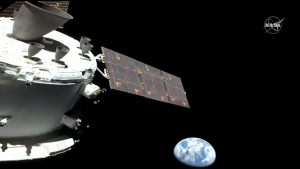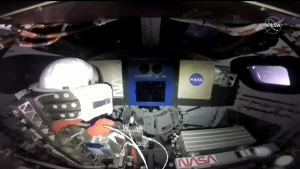
Following a successful launch on Wednesday, Nov. 16, NASA’s uncrewed Orion spacecraft is heading toward the Moon on a 25.5-day mission beyond the lunar surface. Orion lifted off atop the Space Launch System (SLS) rocket at 1:47 a.m. EST from Launch Complex 39B at NASA’s Kennedy Space Center in Florida. Engineers intend to learn as much as possible about Orion’s performance during the flight test and are focused on the primary objectives for the mission: demonstrating Orion’s heat shield at lunar return re-entry conditions, demonstrating operations and facilities during all mission phases, and retrieving the spacecraft after splashdown.

Flight controllers in the Mission Control Center at NASA’s Johnson Space Center in Houston successfully completed the first outbound trajectory correction burn by the European-built service module’s main engine as planned at 9:32 a.m. The burn tested Orion’s main engine for the first time and adjusted the spacecraft’s course toward the Moon. Several additional course correction burns are planned on journey.
While Orion began its trek toward the lunar environment, 10 CubeSats deployed by timer from an adapter still attached to the SLS’s upper stage. Each CubeSat has different timelines for acquiring a signal with its mission operators.
Flight controllers performed a modal survey, a test to verify that the models and simulations used to design Orion’s solar array wings accurately reflect the motion that is occurring in flight. This was accomplished by firing Orion’s reaction control system thrusters and observing how the solar array wings react to that specific firing sequence. Engineers also calibrated the optical navigation system and gathered imagery using the spacecraft’s cameras. Orion is outfitted with multiple cameras used for various functions such as engineering as well as sharing the progress of the mission with the public.
Scheduled for Thursday is the second outbound trajectory burn using the auxiliary thrusters, which will be used for most trajectory correction burns.
To watch the launch broadcast replay, click here: https://www.youtube.com/watch?v=CMLD0Lp0JBg
To watch the post-launch press conference, click here: https://www.youtube.com/watch?v=YGt-ilMv5U0
